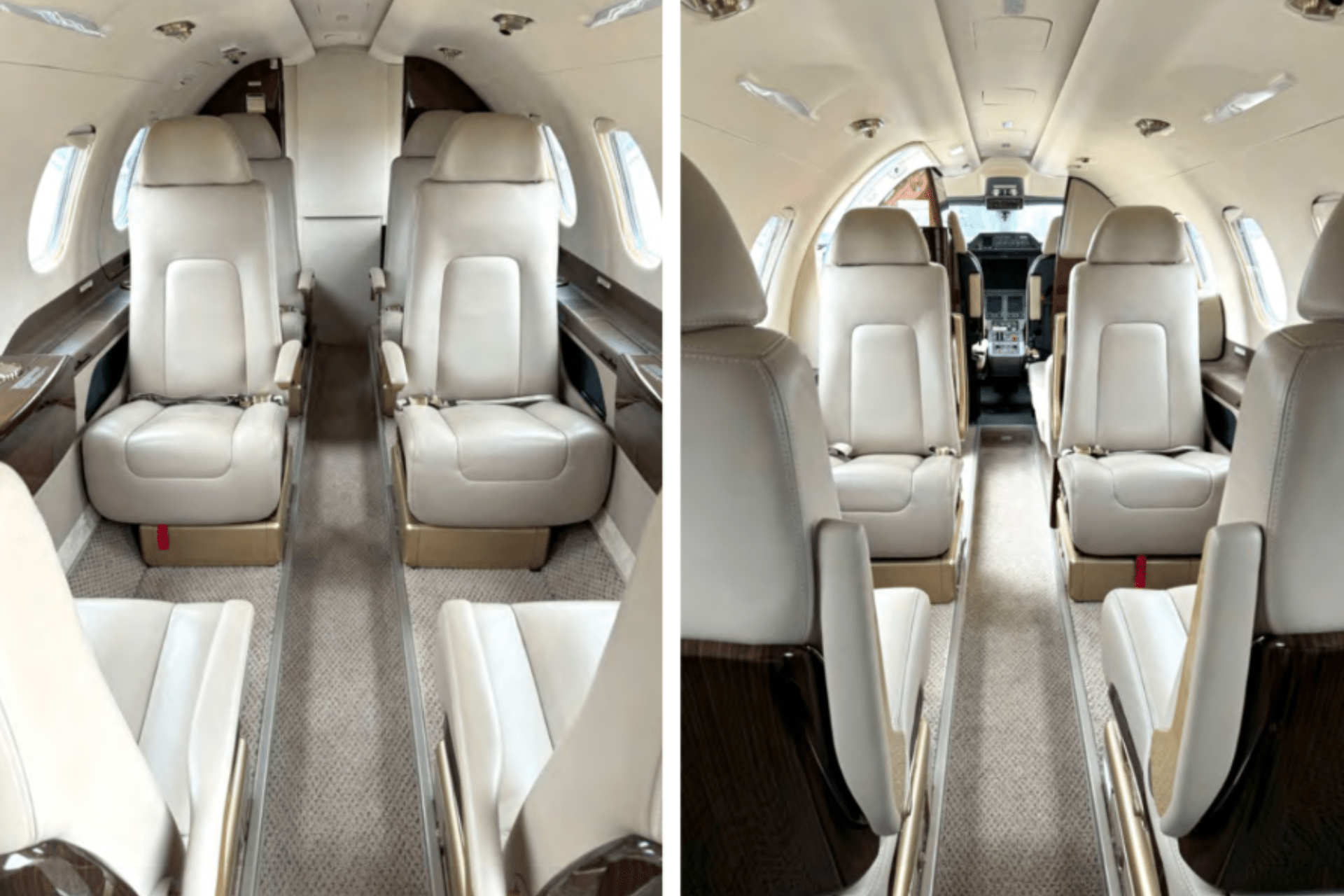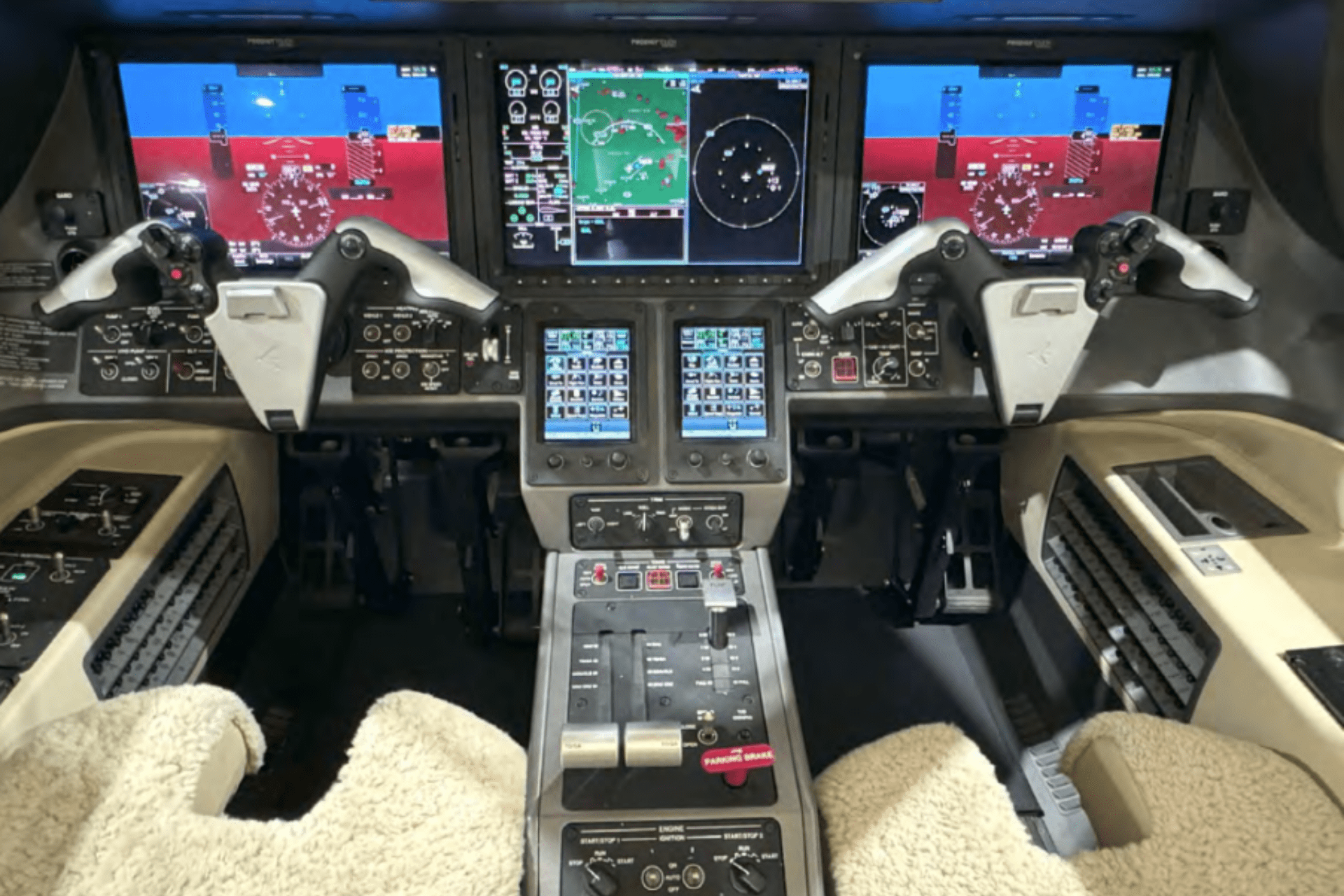The Phenom 300: A Complete Buyer's Guide
Published on 06/09/25

This guide breaks down what you actually need to know before buying a Phenom 300 jet: performance, layout, upgrades, and most importantly, why it's the world's best-selling light business jet.
What is the Embraer Phenom 300?
The Phenom 300 is a light jet built for serious business travel. It’s fast, efficient, and consistently ranks among the most-delivered business jets in the world, for good reason.
You’re looking at a jet that flies just under Mach 0.80, carries up to nine passengers, and can run nonstop missions around 2,000 nautical miles. That gives you real flexibility, especially if your routes include longer stage lengths or frequent regional trips.
The Phenom 300 isn’t just high-performing—it’s reliable, intuitive to operate, and built with a cabin layout that makes smart use of every inch. It's one of the few light jets that consistently balances performance, comfort, and long-term value.
Dimensions, Layouts, and Passenger Comfort

This is where the Phenom 300 punches above its weight. It offers a surprising amount of usable space, without wasted square footage or awkward cabin design. It was built for business missions, but doesn’t sacrifice comfort for performance.
Cabin Size, Seating Configurations, and Baggage Space
The cabin height comes in at just under five feet, but it feels more spacious than the number suggests, thanks to innovative design. You’ll typically see a club seating configuration, sometimes with a belted lav and side-facing divan to bring capacity up to eight or nine.
There’s a 76-cubic-foot external compartment that handles full-size suitcases without breaking a sweat. It’s rare to find that kind of storage in this class.
Cabin Amenities: Connectivity, Workability, and Comfort
This jet’s not just for riding—it’s built for working. The cabin includes power outlets at every seat, optional Wi-Fi, and a refreshment center. Large windows are the perfect complement to long flights and productive work time.
Depending on the specification, some models are equipped with touchscreen controls for lighting, temperature, and entertainment.
Crew Considerations and Flight Deck Ergonomics
This is where both owner-operators and two-pilot teams benefit. Around 2015, the Garmin G3000 flight deck was introduced. It’s intuitive, clean, and designed for high situational awareness. You’ll also find that cockpit access is smartly laid out. There’s no crowding, and visibility is solid for a light jet.
Performance Specs
The Phenom 300’s performance made it a best-seller, so it keeps showing up in serious acquisition conversations. It’s fast, efficient, and fits into more airports than most jets in its class.
Range, Speed, Runway Requirements
The Phenom 300 cruises at up to 453 knots and has a max range of around 2,000 nautical miles. That’s nonstop capability from New York to Dallas, or LA to Chicago, with reserves.
It also has excellent runway flexibility. It can operate from fields under 4,000 feet—meaning access to smaller regional airports, faster departures, and less ground time.
With a max landing weight under 18,000 pounds, the 300 stays light enough to access shorter runways, while still delivering range and cruise speed that rival heavier platforms.
Efficiency and Fuel Burn Compared to Peers
The Phenom 300 burns roughly 170 gallons of fuel per hour. That’s lower than many comparable jets, especially when you factor in the cabin size and speed.
It’s also a low-maintenance platform relative to others in its segment, which helps keep direct operating costs down. Combine that with strong dispatch reliability, and it’s easy to see why fleet operators and charter groups lean heavily on it.

History of the Phenom 300
This jet didn’t come from a legacy airframe or a reworked design. It was built from scratch to do one thing well—bridge the gap between entry-level jets and midsize cabins, with the economics and reliability that business aviation buyers actually want.
A Business Jet Born from Operational Needs
Back in the mid-2000s, there was a hole in the market: buyers needed more speed, space, and range than VLJs could offer, but didn’t want to jump into midsize costs. Embraer saw the opportunity, and the Phenom 300 was the answer.
From the start, it offered a clean-sheet design focusing on real utility. Fast cruise. Big baggage. Simple systems. The result? A jet that worked just as well for high-net-worth individuals as it did for fleet operators and charter programs.
Evolution Since Launch
The original Phenom 300 launched in 2009 and quickly became one of the top-delivered light jets worldwide. Its strong sales reflect clever marketing and its real, consistent strengths that continue to resonate with buyers.
Newer models feature more powerful engines, improved avionics, upgraded cabin materials, and enhanced noise insulation. The 300E also brought in touch-controlled lighting, better in-flight connectivity, and a refreshed cabin layout that feels more in line with larger jets.
Phenom 300 Model Breakdown: Variants and Updates
Over the years, Embraer has made meaningful upgrades—some subtle, others structural. If you’re buying pre-owned or comparing to newer builds, here’s how to tell the difference.
The Phenom 300 vs. 300E
The “E” in 300E stands for “enhanced,” and that’s precisely what you get. The 300E improves on the original with better cabin materials, a quieter interior, and a next-gen in-flight entertainment system.
It also introduces a cabin control interface that’s faster and more intuitive, especially for managing lighting, temperature, and audio. On the resale market, well-maintained aircraft with updated interiors and select pedigree —low hours, clean logs, one owner —can still command a premium.
The 2020 Upgrade: Speed, Avionics, and Cabin Enhancements
In 2020, Embraer rolled out another major refresh, raising cruise speed to Mach 0.80, upgrading the Garmin G3000 flight deck, and refining the cabin with new surfaces, seating, and connectivity options.
The avionics update brought predictive windshear, emergency descent mode, and Runway Overrun Awareness and Alerting System (ROAAS). If you’re comparing listings, check the delivery date and ask whether the aircraft has these 2020 features.
These updates pushed the 300 into the realm of truly advanced aircraft, where avionics, automation, and speed converge to support professional-grade operations.
Phenom 300MED: Specialized Medical Configuration
The Phenom 300 MED is a fully certified medevac configuration developed with Umlaut and Aerolite. It supports stretchers, life-support equipment, and medical staff seating—all integrated into the cabin without compromising range or dispatch reliability.
Most buyers won’t need this version, but it’s proof of the platform’s flexibility—and something to be aware of if you see modified aircraft on the market.
Note on the Phenom 100: Not the Same Aircraft
Don’t confuse the Phenom 300 series with the smaller Phenom 100. It’s part of the same jet family, but not a direct comparison to the 300.
The Phenom 100 is a very light jet (VLJ) designed for short missions and smaller groups. It may share branding, but it’s an entirely different airframe.
Who Should Own a Phenom 300
This isn’t a starter jet. It’s a business tool that’s best suited for aircraft owners who need a proven platform for repeat use. If your mission profile lines up, the Phenom 300 delivers consistency, flexibility, and long-term value.
The Phenom 300 is for buyers who fly often, care about performance, and need an aircraft that works hard without asking for attention. It’s a tool for principals and pilots, and it thrives in fleet operations that need high dispatch reliability and the ability to operate from smaller airports.
It runs lean, keeps costs predictable, and holds up under frequent use. If that sounds like how you fly, it belongs on your shortlist.
Phenom 300: Frequently Asked Questions
How much does a new Phenom 300E cost?
A new Phenom 300E typically costs between $13 million and $14 million, depending on flight hours, year of delivery, and installed options. Pre-owned aircraft with low time and updated interiors may command a premium, while older airframes with higher flight hours may offer more flexibility on price. It also sees strong performance in the fractional fleet market.
Does a Phenom 300 require two pilots?
No, the Phenom 300 is certified for single-pilot operations. While many owners may choose to fly single-pilot, most operators choose to fly with two for added safety, especially when managing advanced avionics and longer routes. Insurance providers also tend to favor dual-crew operations for aircraft in this class.
Does the Phenom 300 have a toilet?
Yes, the Phenom 300 includes a fully enclosed lavatory. Many versions also feature a belted lap seat, allowing it to count toward passenger capacity. It’s a small but functional layout—typical for a high-efficiency, medium cabin aircraft designed around real mission utility.
Why is the Phenom 300 so popular?
Owners value its consistent strengths—it's the world’s best-selling light jet, and it’s not just a marketing claim—it’s backed by years of sustained market adoption and aircraft in operation. Corporate flight departments value their class performance, fuel-efficient engines, and advanced technology. For buyers in private aviation, it offers a near-perfect balance of cost, speed, and aircraft range.
Ready To Invest in Your Next Aircraft?
Specs are excellent, but they won’t tell you everything. If you’re serious about the Phenom 300, have an honest conversation with industry experts who have sat on your side of the table. No pressure. Just data, 100+ years of experience, and straight answers. Let’s chat about your next aircraft.